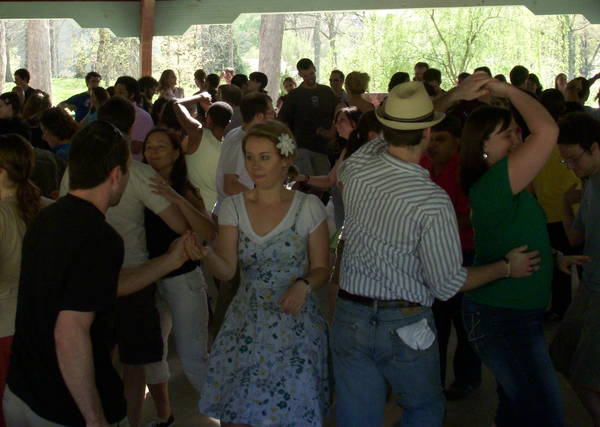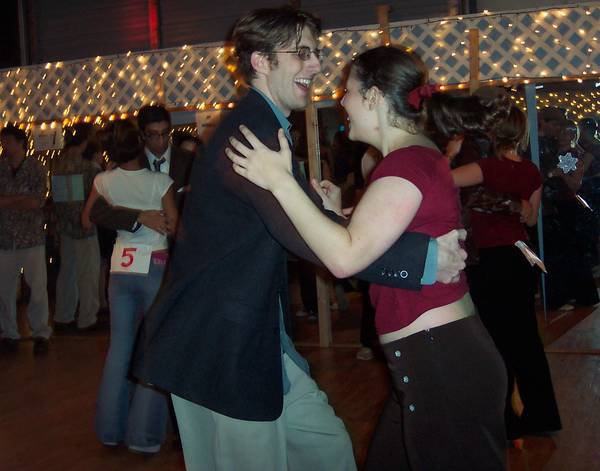Drunk Dancing

“I only dance when I’ve been drinking,” is one of those phrases every social dancer had heard when attempting to encourage a friend to come learn how to dance. It’s not the same as saying, “I don’t dance,” which is a mere acknowledgment that dancing is something one does not enjoy (or thinks they will not enjoy). To qualify the necessity for alcohol often implies that one may like to express oneself through movement, but has difficulty dealing with the self-perceived embarrassment. Such people may fear allowing themselves to feel silly, unless they are under the influence of a substance that can reduce that anxiety. But learning to be silly, together and fully aware, and to move our bodies to music in ways that evoke powerful emotions of love and life, can grant people a freedom to create and enjoy the art form known as dancing.
This isn’t to say social dancers don’t drink, or that many of the dances we have today weren’t inspired by alcohol or other drugs. The swing dance era of the roaring 1920’s and 30’s took place in speakeasys and dance halls filled with people from all walks of life, from the working class, to the highly respectable, and even the dregs of the unsavory. Dancing comes about from a vast number of different muses and inspirations. Musicians, artists, gangsters, farmers and blue collar workers all bring their own flavor of inspiration and style to the way they move their bodies when given that solid beat.
The Peak

Alcohol is not likely to help someone dance better if they only dance while drinking. However for the seasoned dancer, it can help to relax the overactive and over-analytical mind, as well as loosen up muscles and stiff frames. In the engineering world, there is the famous mythos of the Ballmer Peak. A reference to Steve Ballmer, former CEO of Microsoft, and popularized by internet memes1, the Ballmer Peak is the narrow blood alcohol level range at which an engineer has consumed the right amount of booze to gain significant abilities in creativity and coding.
For many dancers, the range of acceptable levels of intoxication to aid in dance, is significantly greater than the narrow band required for engineering software. Of course, dancing is easier and more forgiving that the hard world of code or mathematics. While engineering things can be fun and rewarding, it is cognitively intensive and incredibly frustrating. People can have a bad dance, either with a partner or in a group, when they fail to form a connection. But those frustrations are momentary. The right amount of alcohol can ease those frustrations, invent new form or movement within them, and find ways to make a dance enjoyable; to laugh and find humor and love within silliness. Too much alcohol can have people falling over each other, frustrating sober friends or saying things one may later regret. Like all other things in life involving alcohol, knowing one’s limits is essential.
Large Personalities and Late Night Clubs
If one enters a bar or club with a large group of friends and a crowded dance floor, the barrier to dancing is quite low. Dark rooms, colorful lights and carefully formulated modern pop music add to the energy which builds to the point where it must be danced out. However, if the dance floor is empty, the barrier is higher. Sometimes it is the inebriated whose lack of inhibitions leads them to be the first out on the floor, but more often than not, it’s simply those with loud, uninhibited and flamboyant personalities.
Whether its the good old boy farmer and car dealership owner, or the birthday tiara wearing, colorful, “take your shirt off” wild girl, bright people have a gravity in their personalities that pulls everyone in their wake. It does not matter if they’ve have zero drinks or five, because they seemingly have no fear of embarrassment. They embrace music, dance, their own bodies and expression. It only takes one or two, and then five, then twenty and eventually the floor is flooded by souls hypnotized by samples of Iggy Pop used in some drum and bass remix of that terrible Taylor Swift song (you know the one; don’t pretend you don’t).
Like a Child
It’s not terribly difficult to get children to dance. The shy ones might only dance around their family or people they know, but once you get some music playing, it’s not long before you can get kids moving. Dancing is fun, and young people rarely have a fear of silliness. We often encourage children to embrace that playfulness as a way for them to learn and grow, before taming that wild flailing into controlled movements, polite dinner conversation and retirement plans.
What we can learn from that childlike awe is that dancing should, at its heart and core, be fun. In a way alcohol, especially in excess, can allow people to revisit those uninhibited parts of their youth. It can release those fears and self-consciousness tendencies, and can help people embrace the joy of not being afraid of their own bodies.
Learning and Listening
Going to dance classes will not teach you how to dance, but it will help you learn the basics. It starts with a foundation of learning basic beats and moves which, while immensely helpful, shouldn’t be constraining like the strict forms of ballroom. Breaking out of the basics involves immersing yourself in the music. It’s learning how to connect with dance partners, and creating a conversation using those basic structures as a guide.
Social dance classes allow people to experience something new in a room full of peers; people who are also there to enjoy themselves and have fun. It’s in this environment that people ask questions and learn together. With dancers from all backgrounds, skill levels and ages, the barrier to embarrassment, though still present, is diminished.
Dancing often involves combing music, movement and emotion. It challenges our fear of embarrassment, as to participate, one must be willing to look silly. Some feel as if they can only be motivated after a few adult beverages hit their blood stream, yet alcohol need not be a necessity to musicality and movement. A few dance classes, in various forms and genres, can help build a framework for being comfortable with moving to the music. Of course classes are not required to take to the floor, sober or inhibited, as creating one’s own patterns with their bodies is the origin of dance. Alcohol in moderation can reduce inhibition for the reluctant or add enjoyment for the already comfortable dancer. However, when you remove the drinks and are faced with music and a dance floor, the only real hindrance is confidence.
-
Ballmer Peak. XKCD. Retrieved 20 July 2017. ↩
